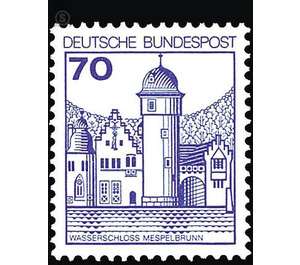Postage stamp: castles and palaces - Germany / Federal Republic of Germany 1977 - 70 Pfennig
Theme: Architecture
| Country | Germany / Federal Republic of Germany |
| Issue Date | 1977 |
| Face Value | 70.00 |
| Color | blue |
| Perforation | K 14 |
| Printing Type | Lithography |
| Stamp Type | Postage stamp |
| Item Type | Stamp |
| Chronological Issue Number | 807 |
| Chronological Chapter | GER-BRD |
| SID | 265401 |
| In 80 Wishlists | |
A new series of permanent rolling press with depictions of German castles and palaces replaces the roller-type brand series "Accident Prevention". The postage stamps for 50 and 70 Pfennig appearing as the last two values of this series with the inscription Deutsche Bundespost come out at the same time and in the same motif as the inscription Deutsche Bundespost Berlin. Wasserschloß Mespelbrunn is picturesquely situated in the lonely forests of the Spessart southeast of Aschaffenburg. In 1412, the archbishop of Mainz transferred the site "to Espelborn" to Hamann Echter in gratitude for his services as a forester. This built there around 1419 an unpaved pond house. His son built a "firm house" around 1430. 1519 was the basement of the southeastern part. Peter Echter III. built the plant 1551-1569 as a castle. Significant was his son Julius Echter of Mespelbrunn, who since 1573 was prince-bishop of Würzburg and founder of the local university. After the expiration of the sex (1665) the masters of Ingelheim - since 1737 counts - inherited name and good. You own Schloss Mespelbrunn today. In 1904 they had it removed. The castle rises directly out of the water. It is a three-winged building around a rectangular courtyard with two round towers. The keep was built around 1430 (upper part changed in the 16th century), the other buildings were added in their present form 1551-1569. The southern tract of 1553 with the upper floor of 1725 was romantically enriched around 1840 by a bay window, a gable and the great arch to the keep. The late-Gothic vaulted chapel houses an alabaster altar by Michael Kern (1611), 15th-century Rhenish glass paintings and a Gothic monstrance. (Extract from texts by the German Castle Association e.V. Braubach - Dr. W. Avenarius)


